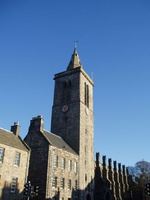St Salvator's College Chapel and Tower
St Salvator's College Chapel and Tower
St Salvator's Chapel is one of St Andrews University's two surviving medieval chapels (the other is St Leonard's Chapel on South Street). It was built in the 1450s by Bishop James Kennedy as a place of worship for the members of his new College of St Salvator. Prior to the founding of St Salvator's the University of St Andrews had been a relatively informal institution where most students and teaching staff lived and worked in private accommodation. Kennedy wished to create a university college along the lines of those at Oxford and Cambridge, and to this end constructed a large complex of buildings including a dining hall and cloister (both of which have since been demolished). The chapel was lavishly furnished with valuable statues (including a large silver image of Christ the Saviour), fine paintings, and altar hangings of cloth of gold. Few of these treasures survived the Reformation.
Elizabeth Swarbrick on the history of St Salvators
Audio description of the Mace of the College of St Salvator
Symbolism of the Mace of the College of St Salvator
Roger Mason on the life and death of Patrick Hamilton, Scotland's first martyr
Street View
Additional Information
Location: North side of North Street. Date Built: Fifteenth to twentieth centuries.
For much of its history St Salvator's College Tower had two bells. One was called Katherine (cast around 1460) and the other was called Elizabeth (cast in 1520). The tower now has six bells to enable change-ringing.
Bishop James Kennedy, the founder of St Salvator's College, also built a large ship called the Salvator. The Salvator weighed 500 tons and was one of the most up to date Scottish warships of its day.
Many distinguished scholars studied at St Salvator's College. During the early sixteenth century the college was headed by John Mair (d.1550) who wrote one of the first scholarly histories of Britain.
In February 1528 Patrick Hamilton, a young academic at the university, was burnt to death outside the gates of St Salvator's College. He was the first Scot to be killed for supporting Protestantism. The site is marked by his initials in the cobbles, and it is thought to be bad luck to walk on them.
In 1547 during the siege of St Andrews Castle French troops placed cannon on the top of St Salvator's Tower.
St Salvator's Chapel originally had a stone-vaulted roof. In 1773 the vault was removed on the grounds that it was unsafe. However, the stone vaulting turned out to be so secure explosives had to be used to demolish it!
